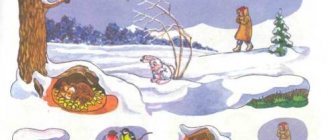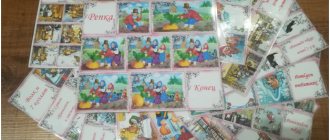Goal: Expand vocabulary on the topic “Clothing”.
Program content:
Correctional educational tasks:
update and expand the vocabulary on the topic “Clothing”;
improve the grammatical structure of speech - train children in the use of the genitive, accusative forms of nouns, in the formation and use of prefixed verbs;
automate the correct pronunciation of the “sh” sound.
Correction and development tasks:
* develop coherent speech, memory, the ability to establish cause-and-effect relationships;
* develop articulatory, fine and gross motor skills.
Correctional and educational tasks:
* develop the ability to listen to your interlocutor;
* cultivate a careful attitude towards clothing.
Integration of educational areas
:
“Cognitive development”, “Speech development”, “Social and communicative development”, “Physical development”.
Preliminary work
:
— Reading fiction on the topic “Clothing” for children 5-7 years old, — conversation about clothes
— Excursion to the Atelier.
— The plot-role-playing game “Atelier”.
Equipment:
TV, PC
.
Demo material:
object pictures depicting clothes, a ball, pieces of various fabrics, a magnetic board, magnets;
Handout:
cut-out pictures on the topic “Clothing”.
GCD move:
| Stages | Activities of a teacher | Children's activities | Targets |
| Organizational stage. Greetings. | The teacher greets the children: Good morning to smiling faces! Good morning to the sun and birds! Let everyone become kind and trusting. May the good morning last until the evening! — Show me, in what mood did you come to study today? — Guys, we have lockers in the reception room. What are they needed for? —Can a person do without clothes? Why does a person need clothes? - What do you think we will talk about today? So let's talk about clothes today. | Children hold hands, smile and say the words all together: Children show emoticons to choose from (happy, sad). — They put clothes in lockers and hang them. — Clothing protects a person from heat, cold, rain, and wind. They answer the question. | |
| Breathing exercises | “Blowing away specks of dust” “Forgot your mittens” “Zip the jacket” "Ironing clothes" | Turn your head straight, inhale, to the right, exhale, pronounce (u); straight-inhale, left-exhale, pronounce (u). 3 times. They inhale, pause, then as they exhale, “warm their fingers,” blow on them, pronouncing (Ш), (Ф), (Х) for a long time. 3 times With the right hand they fasten the lock-inhale, while exhaling they say “Zzhik!” 3 times. Slide your right palm over your left palm, inhale, and as you exhale say “Psh-sh-sh-sh!” 3 times | |
| Exercise “Are we dressing correctly?” | The teacher asks you to sit on chairs. Names the action that we perform when dressing in a modified sequence. For example: We put on a coat and then a jacket. | Children come up to the chairs and sit down. The child finds and corrects an error in the statement. No. We put on a jacket and then a coat. | |
| A game “Remember and name it.” | On the easel there are subject pictures on the topic. The child is asked to remember a series of words (3-5) denoting items of clothing, then repeat it and lay out the corresponding object pictures. | Children watch and remember. Then, after the teacher’s question, they complete the task. | |
| Exercise “Say the opposite.” | The teacher names the first word: Clean - Long - Wet - Thick - Big - New - | Children take turns calling: - dirty - short - dry - thin - small - old | |
| Dynamic pause. | " " The teacher offers to rest and perform a series of movements with him. (Use of ICT) | Children perform movements according to the text. | |
| Exercise “Choose your words.” | It is suggested to name as many words as possible when answering the questions. You can use pictures. What can you sew? Silk dress - which one? What can you connect? What can you tie? What can you wear? | They sit on the chairs. Children raise their hands to answer questions: (dress, coat, sundress, skirt, etc.) (hat, mittens, scarf, sweater, etc.) (scarf, bow on a dress, sundress straps, etc.) (coat, dress, skirt, etc.) | |
| Ball game "One is many." | Imagine the situation: I came to visit you. (The teacher throws the ball, calling a singular noun). I have one hat - and at your house...? I have one dress - I have one trousers - Etc. | The child, having caught the ball, names the genitive case of the noun in the plural. - I have a lot of hats. – I have a lot of dresses. – I have a lot of trousers. | |
| A game "Be careful". | Suggests grouping items depending on their gender into three boxes: 1st box is mine (scarf, suit, jacket, sundress, raincoat, etc.) 2nd box is mine (jacket, shirt, blouse, skirt, etc.) .etc.) 3rd box – mine (dress, coat, etc.) | Children carry out the teacher’s task: arrange the pictures into | |
| Game "At the Garment Factory". | The teacher places pieces of fabric in front of the child. Invites to examine and say what kind of clothes are made from this fabric. From fur - fur From wool - wool From silk - silk Etc. | Children examine and touch the fabric and answer. – fur – wool, etc. | |
| Exercise “Collect a picture.” | The teacher suggests collecting cut-out pictures on the topic | They collect the pictures and look and check whether they collected the pictures correctly. | |
| Reflective stage. | The teacher offers to go to the chairs and sit down. — What new did you learn in class today? — Do you have favorite clothes? Why do you like her? — What did you like in class today? Why? | The children pass and sit down. They recall games and game exercises and express their opinions. |

